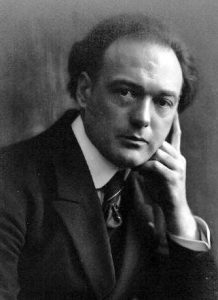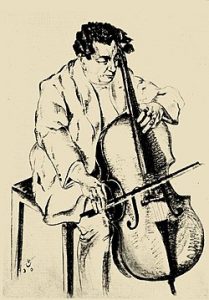Trois Impressions
1926
BBC Radio 3
Composer of the week
Fragment: Podium Witteman
Mike Boddé & Sasha Witteveen
Nuit Calme arranged for contrabass and piano
Beyond Trois Impressions
Written by Elizaveta Agrafenina
(Based on Bosmans biography by Helen Metzelaar)
Important events 1895 – 1926
Henriëtte Hilda Bosmans was born on 6th December in Amsterdam. Her father, the cellist Henri Bosmans died when she was only 8 months old. Her mother, Sara Benedicts who was a pianist and teacher, takes care of Bosmans and makes sure that she is a student of music. She gains a piano teaching certificate cum laude from the Maatschappij tot Bevordering der Toonkunst in Utrecht in 1912.
In 1915, she made a debut as a concert pianist with Utrechtsch Stedelijk Orchest under Wouter Hutschenruyter with piano concert KV 450 by Wolfgang Amadeus Mozart. In 1916 with Concertgebouw Orchestra under Cornelius Dopper with 4th piano concert by Beethoven. The reviews for both concerts are praising her talent and delicate approach. However, the next concert does not go in the same direction and has consequences for Bosmans career as a concert pianist. She is again to be heard with the Utrechtsch Stedelijk Orchest under Wouter Hutschenruyter with an early piano concert of Richard Strauss. She get’s criticized for being unprecise and sloppy in her technique, especially regarding the use of pedal . She doesn’t appear with orchestras until 1921, this time with 4th piano concert by Beethoven. During this time she is focusing more on chamber music and composing.
Bosmans began studying music theory and composition with Jan Willem Kersbergen and instrumentation with Cornelis Dopper (1921–22). Her early works are for solo instruments and ensembles. She writes one of her few works for piano solo Six Preludes (1917), Sonatas for cello (1919) and violin (1918), piano trio (1921), first (1922) and second (1924) cello concertos and her first work for cello and orchestra Poème (1920), which she dedicated to Marix Loevensohn.
It is interesting to note that even if she didn’t grow up with her father, she chose to write many works for cello. All her life, Bosmans worked closely to cellists, and often with members of the Concertgebouw Orchestra. In an interview, she admitted that her favorite instrument was cello.
Trois Impressions
In 1928, Alsbach & Co published Trois Impressions for cello and piano. The cellist Gerhard Hekking performed the pieces in Paris and on a tour in Dutch East Indies.
“In Trois Impressions, Bosmans most intimate feelings seems to be dedicated, as a childlike honour, tot the memory of her father”. – Marix Loevensohn, cellist
“She, the daughter of one of the best cello masters we ever had, she knows how to write for the instrument”. – NRC (28.11.1926)

Gérard Hekking
(24 August 1879 – 5 June 1942)
was a French cellist who worked as first cellist for the Concertgebouw Orchestra from 1903 until 1914. In 1912 Alphons Diepenbrock composed his Berceuse for him and his wife, a soprano. Hekking premiered Fauré’s First and Second Cello Sonatas. Hekking taught cello at the Paris Conservatories.

Marix Loevensohn
(Belgium 31 March 1880 – 24 April France 1943)
was a Belgian cellist. He studied at the Conservatorium van Brussels and his debut was in 1894 in Queens Hall, London. From 1915, he was solocellist at the Consertgebouw Orchestra and in 1928, he formed the Concertgebouw trio together with Louis Zimmermann and Jaap Spaanderman.
Sara Benedicts
(1881 – 1949)
was a pianist. Her debut as a pianist was in 1880 under Johannes Verhulst in Felix Meritis hall where she played the second pianoconcerto by Camille Saint-Saëns. She taught piano for 40 years at the Amsterdam Conservatory.
Henri Bosmans
(1856 – 1896)
was a cellist with Concertgebouw Orchestra. He was a very actice chamber musician and played with names such as Julius Röntgen, Willem Kes, Joseph Cramer, Hendrik Willem Hofmeester en Christian Timmner. In 1884, he performed together with Edvard Grieg the Sonate voor cello en piano by the Norwegian.
Sheet music
